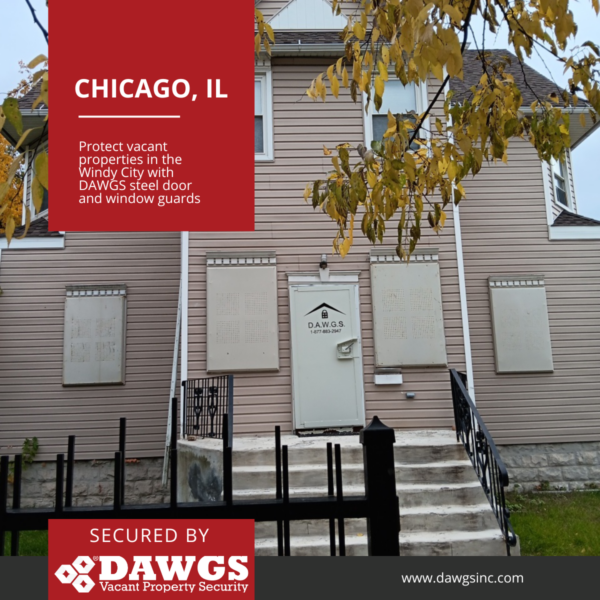Securing Chicago vacant commercial properties is a task that demands meticulous planning and comprehensive strategies. Whether due to relocation, renovation, or market conditions, unoccupied commercial spaces are vulnerable to various risks. In this blog post, we present the ultimate checklist for Chicago property owners and managers to fortify vacant commercial properties, protecting assets and maintaining community safety.

DAWGS door and window guards securing vacant properties in Chicago
1. Assess Property Vulnerabilities
Begin by conducting a thorough assessment of the property’s vulnerabilities. Identify potential entry points, weak spots in the security infrastructure, and areas susceptible to damage or deterioration.
2. Strengthen Entry Points
Reinforce all entry points, including doors, windows, and loading docks. Consider upgrading locks, installing security doors, and using shatter-resistant glass to deter break-ins.
3. Install Adequate Lighting
Ensure the property is well-lit to discourage criminal activities. Use motion-activated lights for exterior spaces, parking lots, and entrances to enhance visibility during nighttime.
4. Utilize Visible Signage
Display prominent signs indicating that the property is monitored and that trespassing is prohibited. Clear communication can deter potential intruders and signal active security measures.
5. Implement Video Surveillance
Install a robust video surveillance system with strategically placed cameras. Regularly check and maintain the equipment, and ensure that cameras cover critical areas of the property.
6. Secure the Perimeter with Fencing
Surround the property with sturdy fencing to establish a clear boundary. A well-designed fence adds an extra layer of security and discourages unauthorized access.
7. Utilize Remote Monitoring Technology
Incorporate remote monitoring systems that allow real-time observation of the property. Remote monitoring enables swift responses to security threats, even when you’re not physically present.
8. Maintain Landscaping Regularly
Keep the exterior of the property well-maintained. Regular landscaping not only enhances the property’s appearance but also reduces the likelihood of criminal interest.
9. Implement Fire Prevention Measures
Minimize the risk of fires by removing combustible materials, ensuring proper storage of flammable items, and maintaining electrical systems in good working order.
10. Remove Valuables from the Property
If possible, remove valuable equipment, inventory, and other assets from the premises to eliminate the incentive for theft.
11. Secure HVAC Systems and Utilities
Ensure that HVAC systems are properly secured to prevent theft and vandalism. Additionally, shut off unnecessary utilities to reduce the risk of accidents.
12. Board Up Windows and Doors
Secure windows and doors by boarding them up. This not only deters break-ins but also protects the property from weather-related damage.
13. Engage with Local Law Enforcement
Establish positive communication with local law enforcement. Keep them informed about the property’s vacant status and request advice on additional security measures.
14. Community Outreach and Collaboration
Inform neighboring businesses and residents about the property’s vacancy. Encourage them to report any suspicious activities promptly, fostering a sense of community vigilance.
15. Adhere to Local Regulations
Stay informed about local ordinances and regulations regarding vacant commercial properties. Compliance ensures legal adherence and avoids potential fines.
16. Document Security Measures
Maintain detailed records of all security measures implemented, including installation dates and maintenance schedules. This documentation is valuable for reference and accountability.
Securing vacant commercial properties in Chicago requires a multi-faceted approach. By following this ultimate checklist, property owners and managers can fortify their assets, minimize risks, and contribute to the overall safety and well-being of the community.




